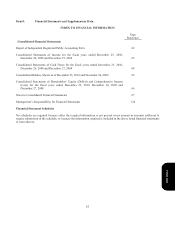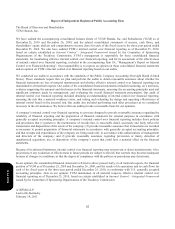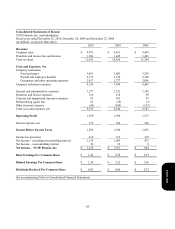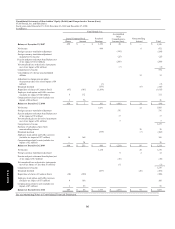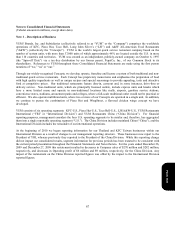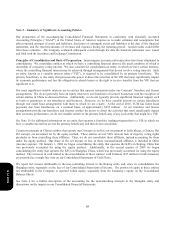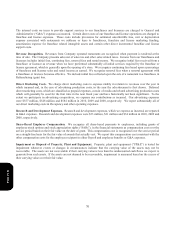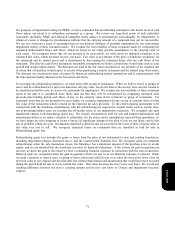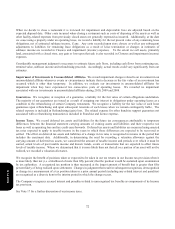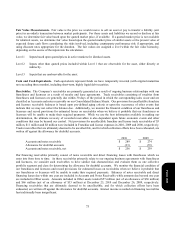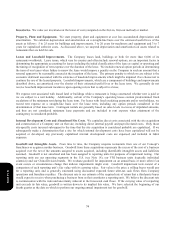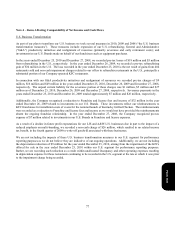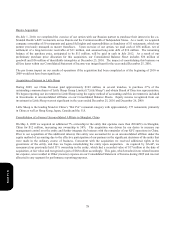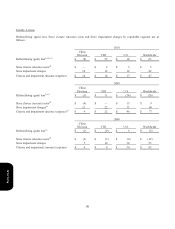Pizza Hut 2010 Annual Report Download - page 168
Download and view the complete annual report
Please find page 168 of the 2010 Pizza Hut annual report below. You can navigate through the pages in the report by either clicking on the pages listed below, or by using the keyword search tool below to find specific information within the annual report.
71
For purposes of impairment testing for PP&E, we have concluded that an individual restaurant is the lowest level of cash
flows unless our intent is to refranchise restaurants as a group. We review our long-lived assets of such individual
restaurants (primarily PP&E and allocated intangible assets subject to amortization) semi-annually for impairment, or
whenever events or changes in circumstances indicate that the carrying amount of a restaurant may not be recoverable.
We use two consecutive years of operating losses as our primary indicator of potential impairment for our semi-annual
impairment testing of these restaurant assets. We evaluate the recoverability of these restaurant assets by comparing the
estimated undiscounted future cash flows, which are based on our entity specific assumptions, to the carrying value of
such assets. For restaurant assets that are not deemed to be recoverable, we write down an impaired restaurant to its
estimated fair value, which becomes its new cost basis. Fair value is an estimate of the price a franchisee would pay for
the restaurant and its related assets and is determined by discounting the estimated future after-tax cash flows of the
restaurant. The after-tax cash flows incorporate reasonable assumptions we believe a franchisee would make such as sales
growth and margin improvement. The discount rate used in the fair value calculation is our estimate of the required rate
of return that a franchisee would expect to receive when purchasing a similar restaurant and the related long-lived assets.
The discount rate incorporates rates of returns for historical refranchising market transactions and is commensurate with
the risks and uncertainty inherent in the forecasted cash flows.
In executing our refranchising initiatives, we most often offer groups of restaurants. When we believe stores or groups of
stores will be refranchised for a price less than their carrying value, but do not believe the store(s) have met the criteria to
be classified as held for sale, we review the restaurants for impairment. We evaluate the recoverability of these restaurant
assets at the date it is considered more likely than not that they will be refranchised by comparing estimated sales
proceeds plus holding period cash flows, if any, to the carrying value of the restaurant or group of restaurants. For
restaurant assets that are not deemed to be recoverable, we recognize impairment for any excess of carrying value over the
fair value of the restaurants which is based on the expected net sales proceeds. To the extent ongoing agreements to be
entered into with the franchisee simultaneous with the refranchising are expected to contain terms, such as royalty rates,
not at prevailing market rates, we consider the off-market terms in our impairment evaluation. We recognize any such
impairment charges in Refranchising (gain) loss. We classify restaurants as held for sale and suspend depreciation and
amortization when (a) we make a decision to refranchise; (b) the stores can be immediately removed from operations; (c)
we have begun an active program to locate a buyer; (d) significant changes to the plan of sale are not likely; and (e) the
sale is probable within one year. Restaurants classified as held for sale are recorded at the lower of their carrying value or
fair value less cost to sell. We recognize estimated losses on restaurants that are classified as held for sale in
Refranchising (gain) loss.
Refranchising (gain) loss includes the gains or losses from the sales of our restaurants to new and existing franchisees,
including impairment charges discussed above, and the related initial franchise fees. We recognize gains on restaurant
refranchisings when the sale transaction closes, the franchisee has a minimum amount of the purchase price in at-risk
equity, and we are satisfied that the franchisee can meet its financial obligations. If the criteria for gain recognition are
not met, we defer the gain to the extent we have a remaining financial exposure in connection with the sales transaction.
Deferred gains are recognized when the gain recognition criteria are met or as our financial exposure is reduced. When
we make a decision to retain a store, or group of stores, previously held for sale, we revalue the store at the lower of its (a)
net book value at our original sale decision date less normal depreciation and amortization that would have been recorded
during the period held for sale or (b) its current fair value. This value becomes the store’s new cost basis. We record any
resulting difference between the store’s carrying amount and its new cost basis to Closure and impairment (income)
expense.
Form 10-K


